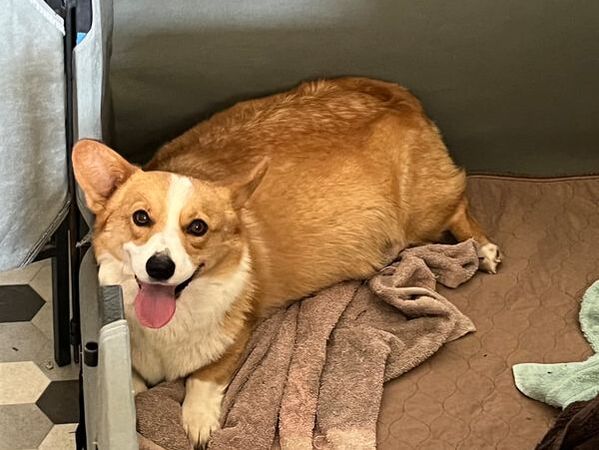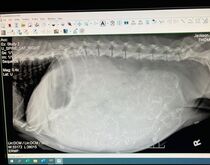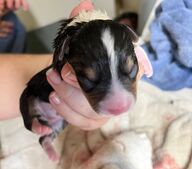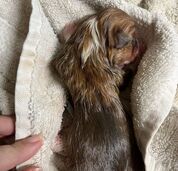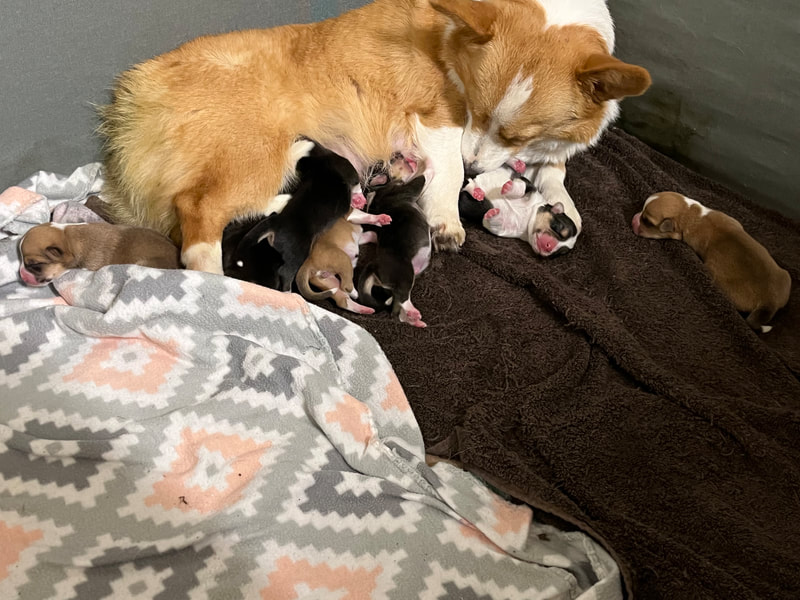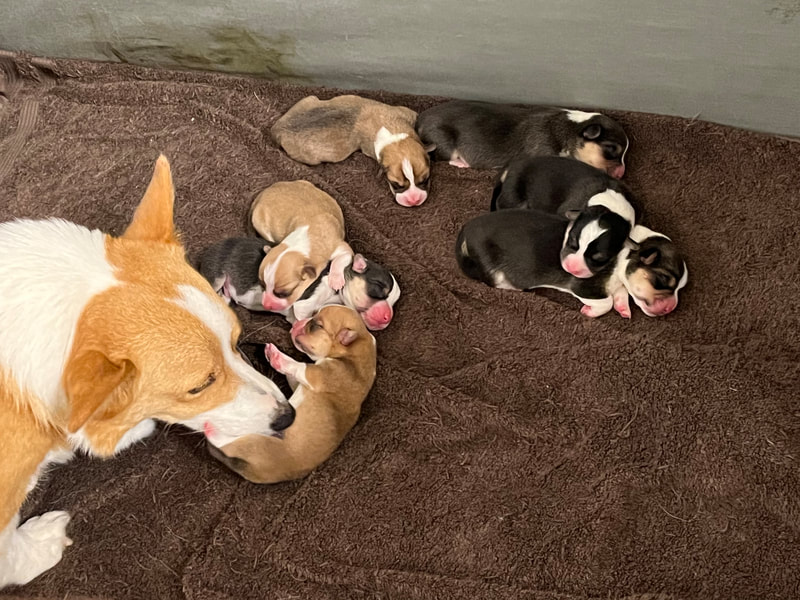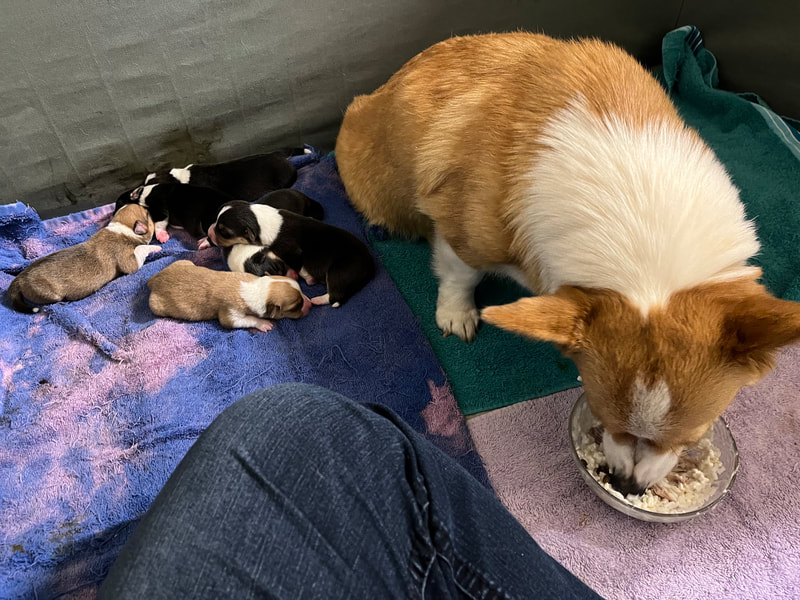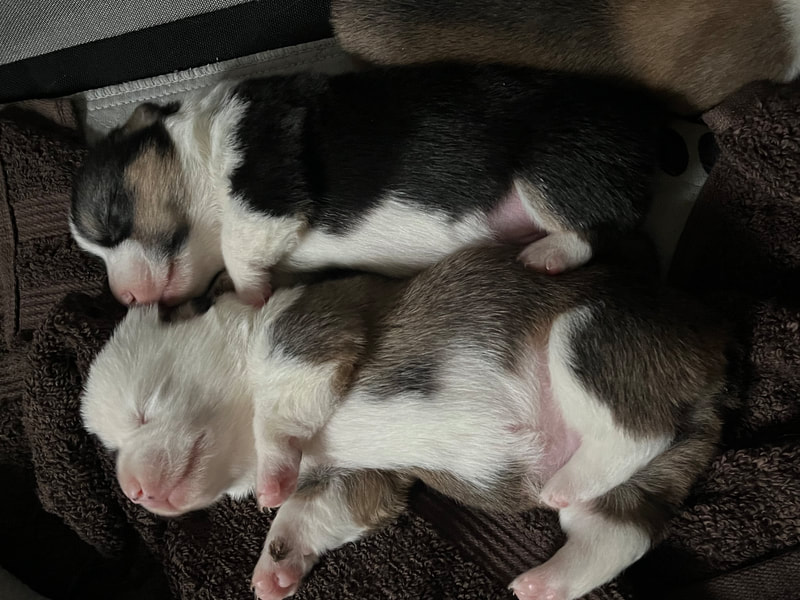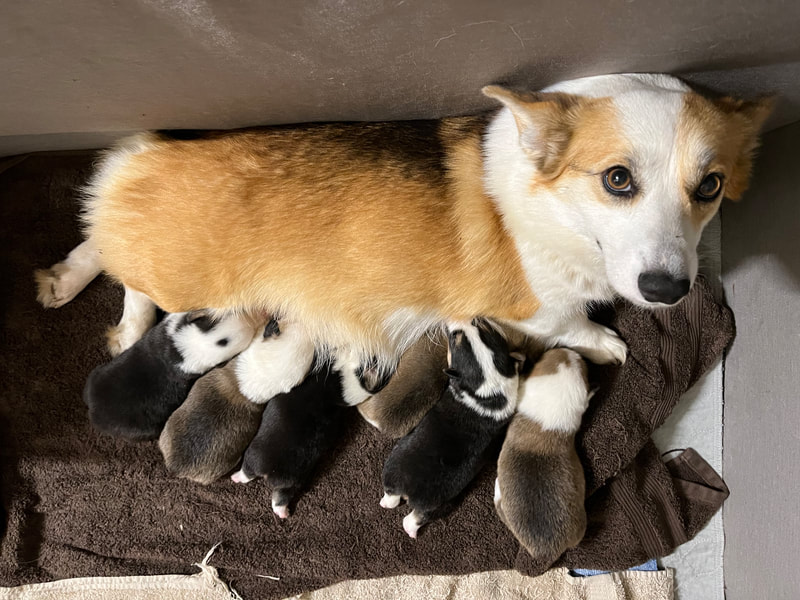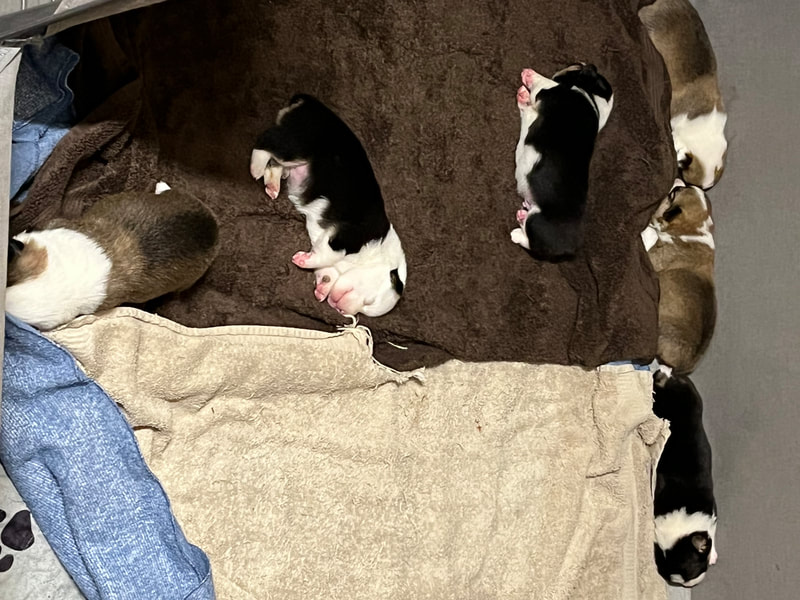How We Raise Our Corgi Pups
Our Corgis are raised in our home with love, care, and a ton of attention. Our adults enjoy cuddles, snuggling on our bed, treats, car rides, visiting friends at ranches, going for walks at local lakes, and just being with us. They are a big part of our lives and are loved like the family members that they are. When we have litters, the puppies are raised in our home with the utmost care and monitoring of both babies and mom.
Many people ask us the process of how our pups are raised, so we've put this page together to give everyone an inside look and generalized idea of what we do.
Many people ask us the process of how our pups are raised, so we've put this page together to give everyone an inside look and generalized idea of what we do.
|
|
|
Expecting Puppies
When we select a stud dog to breed to one of our females, we take many things into consideration: temperament, size, conformation, energy level, and personality traits. When litters prove to be a nice pairing and many happy owners report great qualities in their pups, we often will repeat the pairing.
After a successful pairing, we start getting mom comfortable in her whelping box area around 45 days into the pregnancy. At 55-59 days, we will take mom to the vet to have a puppy count X-Ray done. With this X-Ray, we are able to determine a pretty accurate puppy count and check on skull sizes compared to pelvic bones to make sure mom shouldn't have difficulties during delivery. In the coming days after the X-Rays we stay very close to home and monitor mom for pre-labor behaviors. We keep track of how long mom has been showing labor signs, started having contractions, when a water broke, and any important notes throughout the delivery. If something doesn't seem to be going as it should, we don't hesitate to take mom for an emergency c-section. The safety of mom and babies is the biggest priority.
After a successful pairing, we start getting mom comfortable in her whelping box area around 45 days into the pregnancy. At 55-59 days, we will take mom to the vet to have a puppy count X-Ray done. With this X-Ray, we are able to determine a pretty accurate puppy count and check on skull sizes compared to pelvic bones to make sure mom shouldn't have difficulties during delivery. In the coming days after the X-Rays we stay very close to home and monitor mom for pre-labor behaviors. We keep track of how long mom has been showing labor signs, started having contractions, when a water broke, and any important notes throughout the delivery. If something doesn't seem to be going as it should, we don't hesitate to take mom for an emergency c-section. The safety of mom and babies is the biggest priority.
The First Four Weeks After Birth
After birth, mom and the new babies are closely monitored. Their initial whelping room is next to my bedroom so I can hear any potential squeaks of distress or if mom is needing to go out to potty. The whelping room is kept at a steady temperature around 80 degrees and heating pads are available in the whelping boxes in one corner (under the box) if pups need a warmer spot in the box. We have baby monitor cameras up on the whelping box areas during this time so we can check on them from our phones if we need to step outside.
In the first several days after birth, mom may have an upset tummy from eating afterbirth or just because she doesn't want to leave her pups for very long. Some of our moms will also become picky eaters and need special tasty meals made for them. We have to watch them eat some of their food because they might try to bury it in their box when we're not looking. We keep fresh water and extra meals coming to the moms during these vital early stages of motherhood. We frequently check to make sure pups all seem to be nursing normally and gaining weight well. Sometimes we may have pups that don't seem to be thriving that we may have to help out for the first several days to a few weeks.
At 2-4 days old, we take the pups to our vet to have tails docked and dewclaws removed in accordance to the AKC breed standard for Pembroke Welsh Corgis. Between 1-4 weeks of age, we submit any genetic testing swabs on the pups. At 2-3 weeks of age, puppies get their first round of worming done and have their first little nail trims. Between 2 and 3 weeks, puppies start opening their eyes and testing out their legs. Mom is nursing much harder so we are pushing plenty of extra food to her to support her and the growing pups. Moms not only get tasty meals with chicken or ground beef and cottage cheese, they're also given vitamin supplements throughout their pregnancy and while lactating. During these first few weeks, we spend a great deal of time caring for and monitoring mom and babies.
In the first several days after birth, mom may have an upset tummy from eating afterbirth or just because she doesn't want to leave her pups for very long. Some of our moms will also become picky eaters and need special tasty meals made for them. We have to watch them eat some of their food because they might try to bury it in their box when we're not looking. We keep fresh water and extra meals coming to the moms during these vital early stages of motherhood. We frequently check to make sure pups all seem to be nursing normally and gaining weight well. Sometimes we may have pups that don't seem to be thriving that we may have to help out for the first several days to a few weeks.
At 2-4 days old, we take the pups to our vet to have tails docked and dewclaws removed in accordance to the AKC breed standard for Pembroke Welsh Corgis. Between 1-4 weeks of age, we submit any genetic testing swabs on the pups. At 2-3 weeks of age, puppies get their first round of worming done and have their first little nail trims. Between 2 and 3 weeks, puppies start opening their eyes and testing out their legs. Mom is nursing much harder so we are pushing plenty of extra food to her to support her and the growing pups. Moms not only get tasty meals with chicken or ground beef and cottage cheese, they're also given vitamin supplements throughout their pregnancy and while lactating. During these first few weeks, we spend a great deal of time caring for and monitoring mom and babies.
Five to Eight Weeks of Age
The real fun begins!
The puppies start getting much more active and their ears start to grow. We do another round of worming at 4-5 weeks. Mom and babies move to a bigger whelping room with a play pen. Pups get started on "puppy mush" and we slowly transition them to more solid food in the coming weeks. In their play pen, puppies get started on newspaper potty training and litter box training. We also add an open plastic crate and a multitude of toys for the puppies to play with. Mom starts weaning the pups off and becomes less interested in cleaning up after them.
At around 5 weeks, we will open up applications for families actively seeking a Corgi puppy. The puppies also start developing their personalities and learning to play. We have them out for playtime in the house several times throughout the day and they learn to socialize with people and our cats. We also being introducing them to potential families through a variety of photos and videos on our Facebook page. We will do their initial photos introducing colors, genders, and identifying collars/markings. Around 6.5-7 weeks, the babies start to enjoy outside time! (and another round of worming) Weather pending, we start them in small increments to let their immune systems adjust to the outside. Babies progressively spend more time outside during the day playing with each other, mom, and occasionally some of the other Corgis.
At close to 8 weeks, the pups go to our vet for their wellness exams prior to leaving our care. We get letters from the vet for all families to go in their puppy folders when they pick up their pups. At this stage, pups are on dry kibble with a free-feeding schedule (we do this initially to prevent competitive food behaviors). They will also get their first puppy booster shot either given by us or by the vet during their visit.
The puppies start getting much more active and their ears start to grow. We do another round of worming at 4-5 weeks. Mom and babies move to a bigger whelping room with a play pen. Pups get started on "puppy mush" and we slowly transition them to more solid food in the coming weeks. In their play pen, puppies get started on newspaper potty training and litter box training. We also add an open plastic crate and a multitude of toys for the puppies to play with. Mom starts weaning the pups off and becomes less interested in cleaning up after them.
At around 5 weeks, we will open up applications for families actively seeking a Corgi puppy. The puppies also start developing their personalities and learning to play. We have them out for playtime in the house several times throughout the day and they learn to socialize with people and our cats. We also being introducing them to potential families through a variety of photos and videos on our Facebook page. We will do their initial photos introducing colors, genders, and identifying collars/markings. Around 6.5-7 weeks, the babies start to enjoy outside time! (and another round of worming) Weather pending, we start them in small increments to let their immune systems adjust to the outside. Babies progressively spend more time outside during the day playing with each other, mom, and occasionally some of the other Corgis.
At close to 8 weeks, the pups go to our vet for their wellness exams prior to leaving our care. We get letters from the vet for all families to go in their puppy folders when they pick up their pups. At this stage, pups are on dry kibble with a free-feeding schedule (we do this initially to prevent competitive food behaviors). They will also get their first puppy booster shot either given by us or by the vet during their visit.
|
|

